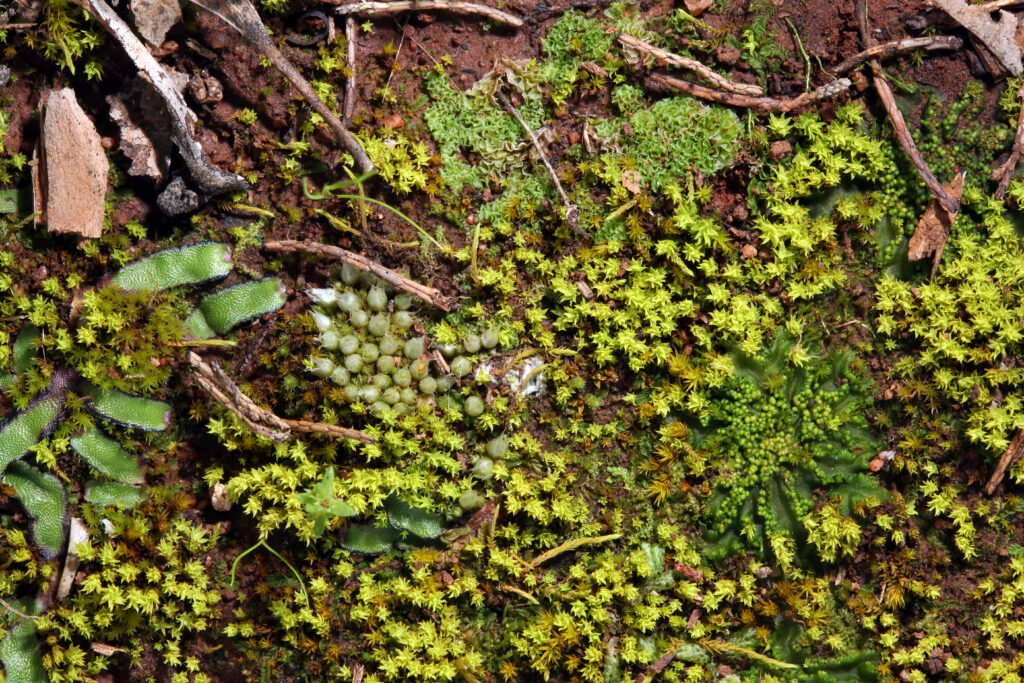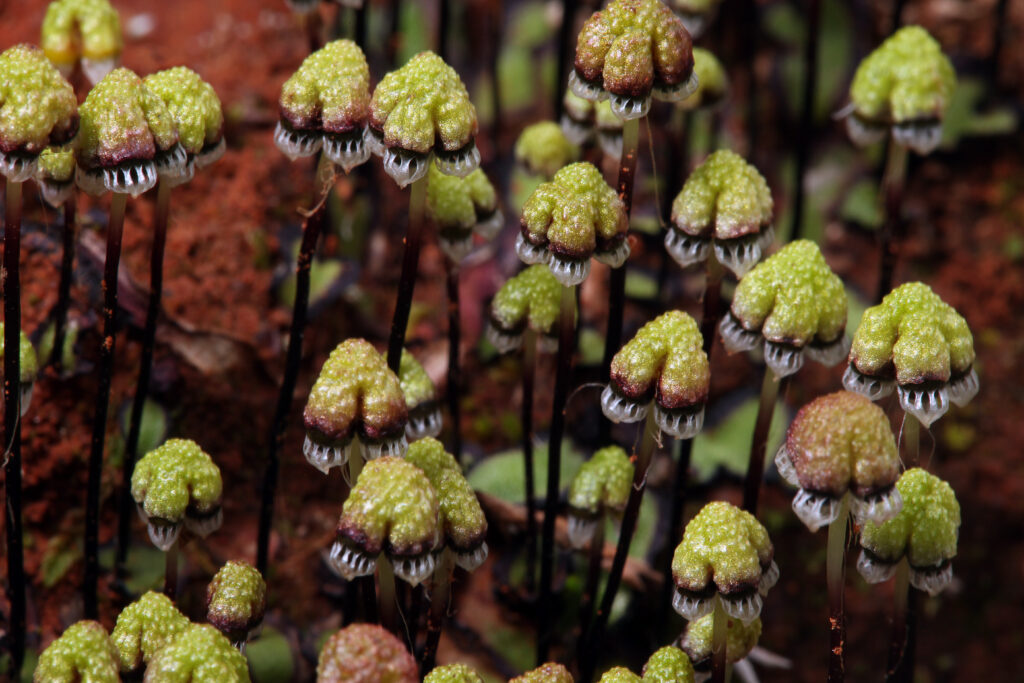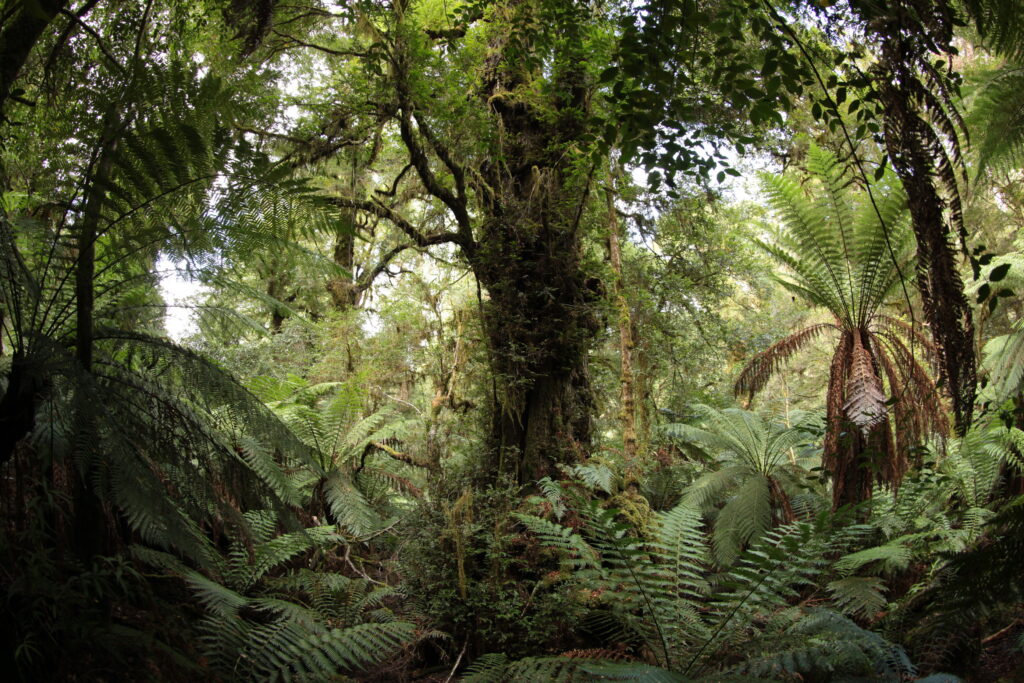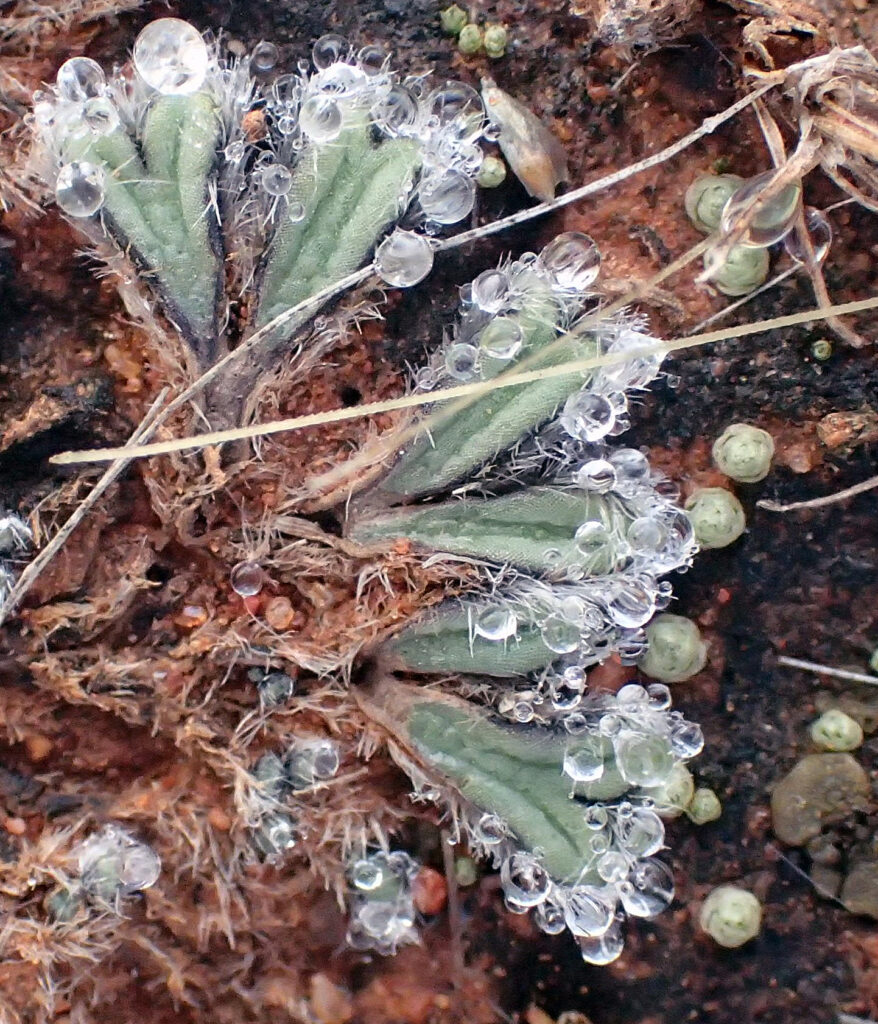Moss Effect: Bryophytes in Victoria’s Ecosystems
By Dr Matt Dell and Dr Josephine Milne
Honorary Associates, Royal Botanic Gardens Victoria

Bryophytes are a group of plants that are familiar to most but are rarely called by their species name – even amongst many botanists. They include mosses, liverworts, and hornworts, and represent some of the smallest plants in the world. Unfortunately, they are among the forgotten species in conservation planning and land management, as their ecosystem requirements and functions are given too little consideration, if any.
Apart from their size, bryophytes possess several traits which allow them to exploit niches not occupied by other plants within an ecosystem. They do not have roots or a complex vascular system like those found in vascular plants (flowering plants, conifers, and ferns), and so most species instead are hydrated mainly by absorbing water at the cell surface.
Small-scale habitats for small-scale plants.
Bryophytes can attach to various surfaces, occupying niches within ‘microhabitats’, without direct competition from most other plants. To appreciate the complexity of these microhabitats, we need to move from a human-sized view of habitats, and instead consider habitats of all scales. The distribution of bryophytes is determined by habitat conditions at the substrate (the surface they grow on), site, and landscape scales.
We also need to widen our usual expectations of how plants disperse from one area of habitat to another. Bryophytes do not have seeds, instead establishing a new population by dispersing spores, or by shedding fragments and specialised structures from their leafy parts. Dispersal may cover several centimetres to several kilometres, depending on the species and conditions. There are important differences in how seed plants and bryophytes disperse, and how genes flow within and between populations. In seed plants, a seed (with embryo) may disperse long distances – aided by wind, water or an animal – and in bryophytes the embryo stays attached to the main plant where it obtains nutrients and water. These differences contribute to how bryophytes and other plants with different life strategies occupy different niches within an ecosystem.
Building and maintaining communities
Bryophyte communities are established through similar processes to vascular plant communities, shaped by changes in environmental conditions that repeat across a site or the landscape. Victoria is rich with different habitat types for plants. The state occupies 3% of the continent and is home to about 20% of Australia’s native flora, or about 4,800 plant species, subspecies or varieties.1,2 Of these, 493 are mosses and 269 are liverworts or hornworts.2

The extent of Victoria’s area is less important for the number of species found, and more for the 28 bioregions that divide the state based on its broad diversity of landscapes.4 Some plants occupy habitats that are subject to seasonal snow cover, extreme heat, prolonged drought and other extremes. Bryophytes occupy all landscapes, right to the extreme ends of Australia’s climatic range.
By 2022, over half of Victoria’s native vegetation and associated habitats had been removed, with the trajectory indicating a continuing net loss today.3 One consequence is that at least 60 of the 762 bryophyte species are now threatened with extinction.1 All remaining natural and modified habitats are important for different bryophytes, while some are well known for their abundance and diversity of species.
The right conditions
Cool temperate rainforests are a favourite place for bryologists, which will come as no surprise to those who’ve spotted the mosses and liverworts they contain. These rainforests are found in sheltered gullies between the Otway Ranges and East Gippsland, where Myrtle Beech (Nothofagus cunninghamii) and/or Southern Sassafras (Atherosperma moschatum) are common canopy trees.
These forests are typically abundant with bryophytes, and home to some of our most recognisable and common species in Victoria, as well as our rarest species. Conditions beneath the closed canopy are typically humid, allowing bryophytes to flourish on almost every surface, including the upper branches of the tree canopy, tree fern trunks, logs, and soil. Species of cool temperate rainforests find their niche within a competitive environment by adapting to micro-variation in light, water availability, temperature, and substrate conditions. Bryophytes also utilise complex physical, chemical and other processes to deal with competition from other plants, such as allelopathy (chemical inhibition) and resource partitioning (using the same resources in different ways). Cool temperate rainforests are a shrinking ecosystem, which contain a significant proportion of Victoria’s bryophyte species, lifeforms and genetic diversity.

Soil ecosystems and arid zones
Bryophytes are not restricted to wetter ecosystems; they are also found in dry woodlands and arid ecosystems. When conditions are dry, they are barely noticeable, but after rain, hues of green become visible on logs on the forest floor, around the base of trees, shaded sides of rocks and soil depressions as the tiny mosses and liverworts that occupy these niches hydrate.
Bryophytes have a number of characteristics that help them to survive harsh conditions between rain events, and through the dry season. Mosses can form dense cushions where water is trapped between overlapping leaves or closely packed stems, which helps retain moisture for extended periods. Others have leaves which curl and twist upon drying to reduce water loss, but will unfurl in seconds after a short shower or heavy dew. Colourless hair points on moss leaves or on the surface of liverworts both reflect the sun’s rays, and also capture droplets of water for rehydration. These features, common in mosses and liverworts forming the living crust on soil, protect the soil from wind and water erosion. Soil crusts also assist with the absorption of water into soil and provide microhabitat for seeds to germinate.
Mosses and liverworts often colonise bare soil. Following fire in woodlands, mosses such as Ceratodon purpureus and Funaria hygrometrica (identified by the orange to red patches they form), are some of the first soil colonisers protecting exposed soil. Some bryophyte species can also occupy saline ecosystems such as saltmarsh. The tiny liverwort Monocarpus sphaerocarpus is one example, found growing on sub-saline soils around saline lakes dominated by samphires (salt-tolerant plants). It is usually found around the base of Beaded Glasswort (Salicornia quinqueflora), but is rarely collected due to its small size and ephemeral (short lasting) nature. Little is known of the duration of its colonies and its life history.
Whether annual or perennial, soil bryophytes have the ability to regenerate or establish quickly following disturbance, making way for other plants to establish over time.
Going to extremes

The alpine biome in Victoria offers another range of ecosystems where bryophytes thrive and contribute to unique high-elevation communities. Alpine peatlands occur above 1200 m above sea level, and include heathlands, grasslands, fens, alpine ponds and tea-tree thickets. These are under snow for some months of the year, and may also experience hot and dry conditions in summer. Sphagnum mosses are perhaps the most commonly associated bryophytes in alpine peatlands. They are widely referred to as “ecosystem engineers” for their role in influencing hydrology, soil chemistry, and the species composition of peatlands.
They are highly efficient at absorbing and storing water – many more times their dry weight – around the outside of their branches and leaves. They thrive in low nutrient, acidic soils which they have a significant role in maintaining for the preservation of their own habitat. Exploration of alpine peatlands will reveal many other bryophyte species, each with their own ecological functions. Larger mosses such as Sphagnum cristatum and Polytrichum commune create hummocks that provide microhabitat variation for other plants and animals. The properties of sphagnum and other mosses have resulted in them being used by humans for centuries, for a range of purposes from insulation, to bedding, to wound dressing.5,6
Despite the many extremes these bryophytes deal with, they can dominate where other plants struggle to establish. They are key to the formation of peat and its capacity to retain moisture, slow down water runoff and sequester carbon.
Interactions with animals (big and small)
Bryophytes are used by birds throughout the world for nest building, with some species favouring mosses over other materials. Mosses are not only good insulation, but they also stay green and camouflaged amongst vegetation, offering added protection against potential predators. Bryophytes (for one reason or another) are not consumed by most animals. Invertebrates are commonly found living amongst their leaves, but they seldom eat bryophytes. Mosses have been recorded amongst the varied diet of some bandicoot species; however, it’s not known if the bandicoots seek them out directly, or instead consume them while foraging for other foods.
Lobes on the leaves of some bryophytes hold a reservoir of external water. Within these, microscopic invertebrates including rotifers, nematodes, and tardigrades have been found living their lifecycle. Tardigrades may consume the content of bryophyte cells, but these animals also seek algae and microscopic animals to feed on.7
Bryophytes often provide the only habitat for these highly diverse and microscopic animals at the bottom of the food chain. Mats of mosses and liverworts harbour larger invertebrates also, and it is not uncommon to see these turned over by foraging birds and mammals on the forest floor. There is no doubt that there are many more interactions between bryophytes and animals than are currently understood.
Discovering more about bryophytes
Anyone with an interest in the natural world will have much to gain from a closer examination of bryophytes. The many niches they occupy can be explored within a single rainforest patch, alpine grassland, samphire shrubland, rock outcrop, coastal dune or even urban environment. Placing a moss or liverwort under the microscope will reveal a miniature world of other organisms which live amongst their varied forms. Bryophytes have an aesthetic charm which is observed throughout the world. Their role in ecosystems contributes significant value to biodiversity, however yet to be fully appreciated.
—
Dr Matt Dell is an Honorary Fellow with the School of Life and Environmental Sciences (Deakin University, Melbourne) and an Honorary Associate at the Royal Botanic Gardens Victoria. His current projects include ecophysiology studies of threatened plants, bryophyte functional trait ecology and biogeography.
Dr Josephine Milne is an Honorary Associate at the Royal Botanic Gardens Victoria. She was the Collections Manager at the National Herbarium of Victoria and now is retired but continues to work on various bryological projects. Currently with a colleague from Canberra, she is focusing on the species diversity, adaptation, distribution, and conservation of bryophytes of Australian Mediterranean climate areas.
References:
- DEECA. (2024). Flora and Fauna Guarantee Act Threatened List. DEECA. www.environment.vic.gov.au/conserving-threatened-species/threatened-list
- DEECA. (2024). Victorian Biodiversity Atlas. DEECA. www.environment.vic.gov.au/biodiversity/victorian-biodiversity-atlas
- VAGO. (2022). Offsetting Native Vegetation Loss on Private Land. Victorian Auditor-General’s Office (VAGO). www.audit.vic.gov.au/report/offsetting-native-vegetation-loss-private-land
- DEECA. (2019). Bioregions and EVC benchmarks. DEECA. www.environment.vic.gov.au/biodiversity/bioregions-and-evc-benchmarks
- Robin Wall Kimmerer. (2021). Gathering Moss. Penguin UK. ISBN 978-0-87071-499-3.
- Drobnik, J., & Stebel, A. (2017). Tangled history of the European uses of Sphagnum moss and sphagnol. Journal of Ethnopharmacology, 209, 41–49. doi.org/10.1016/j.jep.2017.07.025
- Glime, J. M. (2017). Chapter 1 – The Fauna: A Place to Call Home. In Bryophyte Ecology, Volume 2: Bryological Interaction. digitalcommons.mtu.edu/bryophyte-ecology2/1






